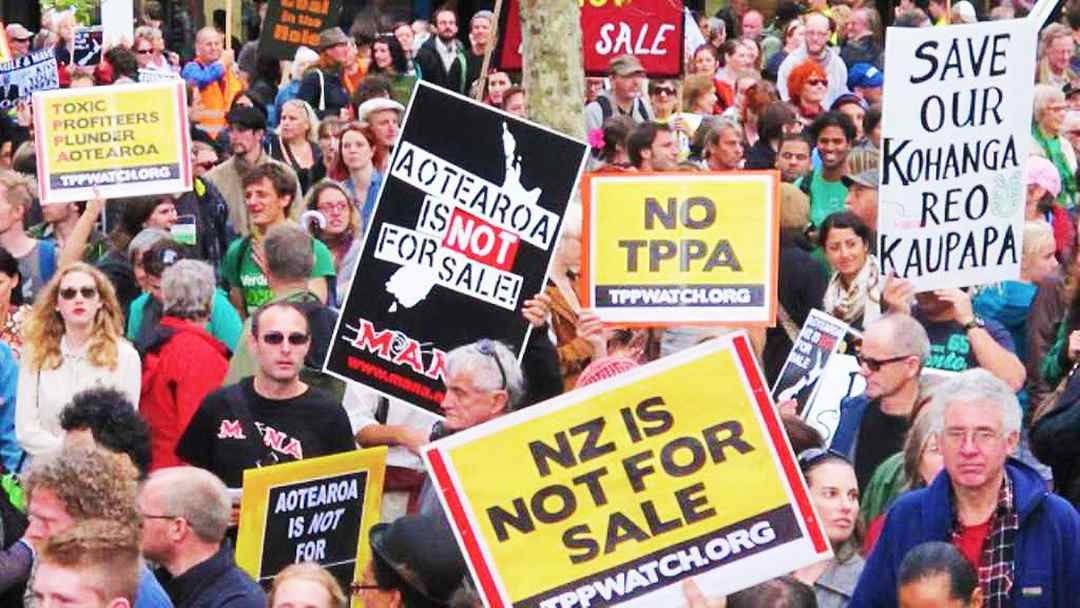
Business
22:50, 05-Mar-2018
TPP members are to sign new pact without US
By CGTN's Owen Poland

Protestors are being urged to take to the streets in New Zealand this week to demonstrate their opposition to a new Trans-Pacific trade pact that will be signed by its 11 member nations in Chile on March 8.
Described by opponents as a "Frankenstein" agreement, the Comprehensive and Progressive Agreement for the Trans-Pacific Partnership (CPTPP) had to be revised after the US withdrew in early 2017 following the election of President Donald Trump who described the original TPP as “a terrible deal”.

President Donald Trump says he will reconsider joining the CPTPP if the US “got a substantially better deal”. /CGTN America Photo
President Donald Trump says he will reconsider joining the CPTPP if the US “got a substantially better deal”. /CGTN America Photo
Whereas the original agreement involving the US accounted for 40 percent of global GDP worth 28 trillion US dollars, the new-look CPTPP – which includes Australia, Brunei, Canada, Chile, Japan, Malaysia, Mexico, New Zealand, Peru, Singapore and Vietnam-accounts for a much more modest 13.5 percent of global GDP worth 10 trillion US dollars.

The Original TPP was signed in New Zealand in February 2016. /US Embassy Photo
The Original TPP was signed in New Zealand in February 2016. /US Embassy Photo
Not surprisingly, expectations about the potential economic benefits have been scaled back. Collectively, the CPTPP is expected to boost the GDP of member states by roughly 0.3 percent or 37.3 billion US dollars in the medium term. In New Zealand’s case, that equates to additional annual trade of 1.2 NZ dollars and 4 billion US dollars.
Nevertheless, gaining preferential access to Japan-the world’s third largest economy-is a major breakthrough for small Pacific Rim countries like New Zealand. In addition to reducing tariffs on beef exports from 38.5 percent to 9 percent over 16 years, Japanese tariffs on apples will be eliminated within 11 years and tariffs on kiwifruit will be removed immediately.
For New Zealand, the CPTPP also effectively represents four new free trade agreements because it provides access to Japan, Canada, Mexico and Peru where tariffs will be eliminated on 92 percent of exports.
New Zealand Trade Minister David Parker says the deal provides “an antidote” to counter growing US protectionism. “CPTPP has become more important because of the growing threats to the effective operation of the World Trade Organization rules,” he said.

New Zealand Trade Minister David Parker says the CPTPP will be an “antidote” to growing US protectionism. /New Zealand Government Photo
New Zealand Trade Minister David Parker says the CPTPP will be an “antidote” to growing US protectionism. /New Zealand Government Photo
The revised trade pact has resulted in the suspension of 22 mainly US-inspired provisions that restrict, for instance, the scope for investors to sue the New Zealand government under the Investor-State Dispute Settlement process. The CPTPP also fully preserves the New Zealand government’s right to protect the national interest in crucial areas like public health, and it recognizes new legislation that will ban foreigners from buying existing residential property.
While the New Zealand government would have liked to have gone further in some areas, Prime Minister Jacinda Ardern said: “We have made significant changes that get us much closer to the kind of agreement that we were always seeking.”

New Zealand Prime Minister Jacinda Ardern says the CPTPP is close to the agreement we were always seeking. /New Zealand Labour Party Photo
New Zealand Prime Minister Jacinda Ardern says the CPTPP is close to the agreement we were always seeking. /New Zealand Labour Party Photo
The CPTPP also has an accession process that allows other trading partners to join in future, and while President Trump has indicated that he would reconsider the partnership if the US got “a substantially better deal”, New Zealand’s Trade Minister said that was “very unlikely” in the short term.
Once the agreement has been signed in Chile it must be ratified by a majority of member nations and is expected to come into force within 12 to 18 months.

SITEMAP
Copyright © 2018 CGTN. Beijing ICP prepared NO.16065310-3
Copyright © 2018 CGTN. Beijing ICP prepared NO.16065310-3